5.3 Classification of Biodiversity
0.0(0)
Card Sorting
1/56
There's no tags or description
Looks like no tags are added yet.
Study Analytics
Name | Mastery | Learn | Test | Matching | Spaced |
|---|
No study sessions yet.
57 Terms
1
New cards
What is the potential problem with using local names for organisms?
* Using different names for the same thing can be confusing
* Science is an international discipline so universal names are needed
* Science is an international discipline so universal names are needed
2
New cards
System of naming used by scientists around the world
Binomial nomenclature → consists of 2 parts (genus, species)
* Universal among biologists and has been agreed and developed at a series of congresses
* Universal among biologists and has been agreed and developed at a series of congresses
3
New cards
Who originally developed the binomial system of nomenclature?
Carl Linnaeus
4
New cards
Genus
A group of species that share common characteristics but may not be able to interbreed *(starts with capital letter)*
5
New cards
Species
A group of organisms in the same genus that are able to interbreed to produce fertile offspring *(starts with lower case)*
6
New cards
The scientific names of two organisms are *Rosa palustris* and *Brassica palustris*.
Why can it not be said that these two organisms belong to the same species?
Why can it not be said that these two organisms belong to the same species?
Even if two organisms have the same species name (in this case both *palustris*), if they are from different genera, they cannot be from the same species. Many species names are descriptive words and translate to things like "common" or a colour.
7
New cards
Example of a subspecies
Organisms placed in the same species and subspecies are able to interbreed to have fertile offspring
* There are two subspecies of the eastern grey kangaroo (*Macropus giganteus)* , the *Macropus giganteus giganteus* and the *Macropus giganteus tasmaniensis.*
* They are able to interbreed to have fertile young but do not in nature due to their geographical isolation
* Neither of *these* subspecies of Eastern grey kangaroo can interbreed with the red kangaroo because it is classified as a different species.
* There are two subspecies of the eastern grey kangaroo (*Macropus giganteus)* , the *Macropus giganteus giganteus* and the *Macropus giganteus tasmaniensis.*
* They are able to interbreed to have fertile young but do not in nature due to their geographical isolation
* Neither of *these* subspecies of Eastern grey kangaroo can interbreed with the red kangaroo because it is classified as a different species.
8
New cards
Taxonomy
The branch of science concerned with classification, especially of organisms
9
New cards
How does the taxa form a hierarchy?
Taxa form a hierarchy based on their degree of relatedness. Organisms in the same species are most closely related, followed by organisms in the same genus, family, order, class, phylum, and kingdom. The further down you go in the hierarchy, the diversity gets fewer. (*groups within groups)*
10
New cards
Binomial nomenclature
A scientist or group that discovers a new species have the right to suggest a binomial name for their discovery. This name has to be approved by one of a number of international bodies before being accepted. These bodies have their roots in the International Zoological Congresses of the late 19th century.
11
New cards
Three domains of classification
* Eukaryota → eukaryotes
* (Eu)bacteria *(“true bacteria”) → bacteria*
* Archaea *(“primitive bacteria”) → archaeans*
* (Eu)bacteria *(“true bacteria”) → bacteria*
* Archaea *(“primitive bacteria”) → archaeans*
12
New cards
Features of Bacteria
* **Histones associated with DNA:** absent
* **Presence of introns: rare or absent** (b/c they are too small)
* **Structure of cell walls:** Made of peptidoglycan
* **Structure of cell membranes:** Glycerol-ester phospholipids
* **Presence of introns: rare or absent** (b/c they are too small)
* **Structure of cell walls:** Made of peptidoglycan
* **Structure of cell membranes:** Glycerol-ester phospholipids
13
New cards
Features of Archaea
* **Histones associated with DNA:** Proteins similar to histones are bound to DNA
* **Presence of introns:** Present in some genes, if they are big enough
* **Structure of cell walls:** Not made of peptidoglycan
* **Structure of cell membranes:** Glycerol-ester phospholipids
* **Presence of introns:** Present in some genes, if they are big enough
* **Structure of cell walls:** Not made of peptidoglycan
* **Structure of cell membranes:** Glycerol-ester phospholipids
14
New cards
Features of Eukaryota
* **Histones associated with DNA:** Present
* **Presence of introns:** Frequent
* **Structure of cell walls:** Not always present + Not made of peptidoglycan
* **Structure of cell membranes:** Glycerol-ester phospholipids
* Often considered pathogenic and disease-causing
* **Presence of introns:** Frequent
* **Structure of cell walls:** Not always present + Not made of peptidoglycan
* **Structure of cell membranes:** Glycerol-ester phospholipids
* Often considered pathogenic and disease-causing
15
New cards
What did Carl Woese discover?
In 1977, while using DNA sequencing information to group organisms, an evolutionary microbiologist called Carl Woese discovered that organisms grouped together into prokaryotes actually had two separate ancestors. Thus he recognized that **Archaea** have a separate line of evolutionary descent from bacteria This disproved the belief that prokaryotes and eukaryotes were the only two lines of living.
16
New cards
What molecule gave scientists the idea that there are two distinct groups of prokaryotes?
The base sequence of rRNA was quite different in Archaea compared to Eubacteria
17
New cards
Where are Archaeans found?
In a broad range of extreme habitats:
* Deep ocean sediment
* Oil deposits
* Water with high salt levels
* High concentrations and temperatures
* Deep ocean sediment
* Oil deposits
* Water with high salt levels
* High concentrations and temperatures
18
New cards
Examples of Archaeans
**Methanogens**: Methanobacterium, Methanococcus
**Extremophiles**: Thermococcus, Halobacterium
**Extremophiles**: Thermococcus, Halobacterium
19
New cards
The Phylogenetic Tree
A tree showing evolutionary relationships and ancestry
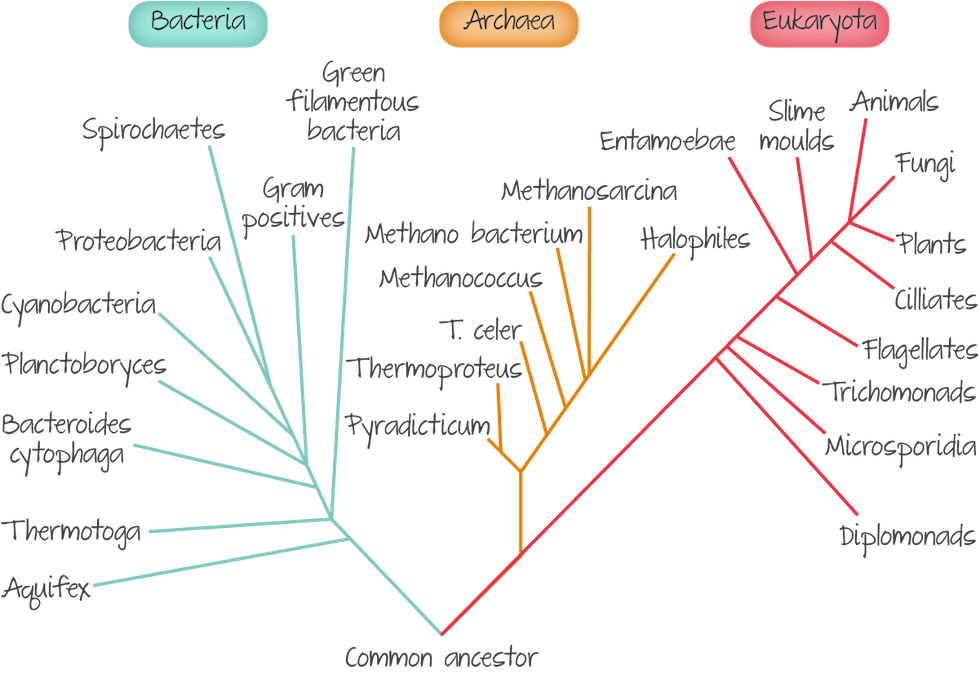
20
New cards
Why are viruses not classified in any of the 3 domains?
Viruses have too few of the characteristics of life to be classified as living organisms: no metabolism and can only produce inside living host cell.
21
New cards
Eubacteria features
* Cell walls have peptidoglycan
* One cell present
* **Autotrophic** or **heterotrophic** nutrition
* Examples: *E. coli* , *Streptococcus*
* One cell present
* **Autotrophic** or **heterotrophic** nutrition
* Examples: *E. coli* , *Streptococcus*
22
New cards
Archaebacteria features
* No peptidoglycan in cell walls
* One cell present
* **Autotrophic** or **heterotrophic** nutrition
* Examples: *Halophiles*
* One cell present
* **Autotrophic** or **heterotrophic** nutrition
* Examples: *Halophiles*
23
New cards
Animalia Features
* Multicellular
* No cell walls
* Mitochondria present
* **Heterotrophic** nutrition (gain organic compounds by eating other living things)
* Carbohydrates stored as glycogen
* Examples: *Mammals, Fish, Insects, Worms*
* No cell walls
* Mitochondria present
* **Heterotrophic** nutrition (gain organic compounds by eating other living things)
* Carbohydrates stored as glycogen
* Examples: *Mammals, Fish, Insects, Worms*
24
New cards
Plantae Features
* Multicellular
* Cell walls made of cellulose
* Mitochondria present
* **Autotrophic** nutrition (contain chloroplasts to carry out photosynthesis)
* Carbohydrates stored as starch
* Examples: *Flowering plants, ferns*
* Cell walls made of cellulose
* Mitochondria present
* **Autotrophic** nutrition (contain chloroplasts to carry out photosynthesis)
* Carbohydrates stored as starch
* Examples: *Flowering plants, ferns*
25
New cards
Fungi Features
* Unicellular or multicellular
* Cell walls made of chitin
* Mitochondria present
* **Saprotrophic** nutrition (gain organic compounds by externally digesting dead organisms and absorbing products)
* Carbohydrates stored as glycogen
* Examples: *Yeasts, mushrooms*
* Cell walls made of chitin
* Mitochondria present
* **Saprotrophic** nutrition (gain organic compounds by externally digesting dead organisms and absorbing products)
* Carbohydrates stored as glycogen
* Examples: *Yeasts, mushrooms*
26
New cards
Protoctista features
* Unicellular (usually)
* Cell walls may/may not be present
* Mitochondria present
* Various modes of nutrition (may or may not contain chloroplasts for photosynthesis)
* Carbohydrates stored as starch or glycogen
* Examples: *Giant kelp, amoeba*
* Cell walls may/may not be present
* Mitochondria present
* Various modes of nutrition (may or may not contain chloroplasts for photosynthesis)
* Carbohydrates stored as starch or glycogen
* Examples: *Giant kelp, amoeba*
27
New cards
Eight taxonomic levels
Domain
Kingdom
Phylum
Class
Order
Family
Genus
Species
Kingdom
Phylum
Class
Order
Family
Genus
Species
28
New cards
__Panda__ binomial classification
**Domain**: Eukaryote
**Kingdom**: Animalia
**Phylum**: Chordata *(spine containing)*
**Class**: Mammalia
**Order**: Carnivora
**Family**: Urisdae
**Genus**: Ailuropoda
**Species**: melanoleuca
**Kingdom**: Animalia
**Phylum**: Chordata *(spine containing)*
**Class**: Mammalia
**Order**: Carnivora
**Family**: Urisdae
**Genus**: Ailuropoda
**Species**: melanoleuca
29
New cards
__Wolf__ binomial classification
**Domain**: Eukaryote
**Kingdom**: Animalia
**Phylum**: Chordata
**Class**: Mammalia
**Order**: Carnivora
**Family**: Canidae
**Genus**: Canis
**Species**: lupus
**Kingdom**: Animalia
**Phylum**: Chordata
**Class**: Mammalia
**Order**: Carnivora
**Family**: Canidae
**Genus**: Canis
**Species**: lupus
30
New cards
__Hibiscus Plant__ binomial classification
Domain: Eukaryote
Kingdom: Plantae
Phylum: Angiospermae
Class: Dicotyledonae
Order: Malvales
Family: Malvaceae
Genus: Hibiscus
Species: rosa-sinensis
Kingdom: Plantae
Phylum: Angiospermae
Class: Dicotyledonae
Order: Malvales
Family: Malvaceae
Genus: Hibiscus
Species: rosa-sinensis
31
New cards
Artificial classification
A method of grouping organisms based on superficial similarities rather than evolutionary relationships. It's a subjective approach that can lead to misclassification. As technology has improved and we have gained further knowledge of organisms and their relationships, artificial classification has become outdated
32
New cards
Natural classification
A system of grouping organisms based on their evolutionary relationships and shared characteristics. It reflects the true relationships between species and helps to understand their evolutionary history. This allows for predictions of characteristics shared by species within a group
* A genus and it’s accompanying higher taxa, consist of all the species that have evolved from one common ancestral species.
* A genus and it’s accompanying higher taxa, consist of all the species that have evolved from one common ancestral species.
33
New cards
Why would grouping animals that can fly like birds, bats and insects together not be appropriate?
Flight evolved separately in these groups, they do not share a common ancestor and differ in many ways. (This would be called artificial classification)
34
New cards
Plants and fungi were at one time classified together. Why do you think scientists did this, and how do we now know that it was incorrect?
They share many features: both have cell walls, no nervous system, don’t move around etc.
But molecular research shows their cell walls evolved separately, and they differ in many other ways
But molecular research shows their cell walls evolved separately, and they differ in many other ways
35
New cards
Convergent evolution
Convergent evolution refers to the process by which different organisms evolve similar traits or characteristics in response to similar environmental pressures, despite not having a common ancestor. This often leads to the development of analogous structures that serve similar functions, but have different evolutionary origins.
→ can make distantly related organisms appear superficially similar (dolphins vs sharks)
→ can make distantly related organisms appear superficially similar (dolphins vs sharks)
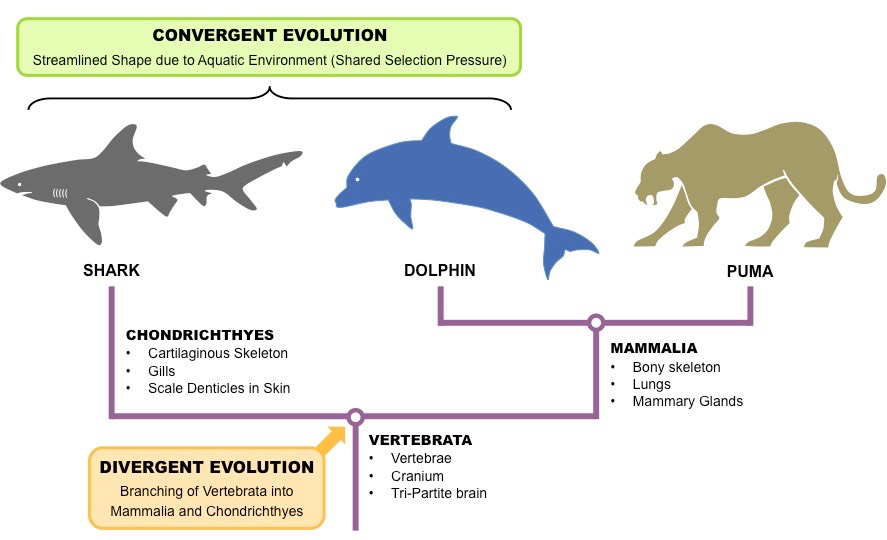
36
New cards
Adaptive radiation
The process by which a single ancestral species evolves into a variety of different forms that are adapted to specific environments and niches. (common ancestor, different features)
→ can make closely related organisms appear different (dolphin vs dog)
→ can make closely related organisms appear different (dolphin vs dog)
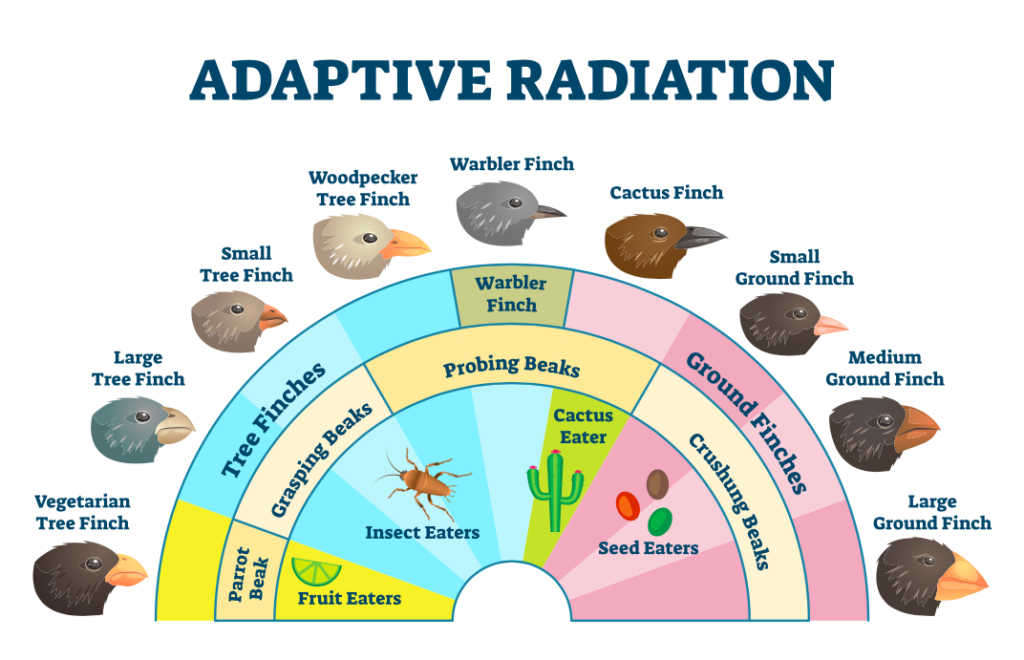
37
New cards
How would classification be reviewed if new evidence showed that members of a group do not share common ancestors?
The group would be split into 2 or more different taxa
38
New cards
How would classification be reviewed if species classified in different taxa were found to be closely related?
2 or more taxa would be united into one OR a species would be moved from 1 genus to another (or between a higher taxa)
39
New cards
How does natural classification benefit the identification of species?
It makes it easier, because they can be assigned to taxa based on characteristics
40
New cards
How does natural classification benefit the predication of shared characteristics?
A common ancestor implies similar characteristics among species, thus is a new species is discovered, we can make prediction about characteristics (physical and behavioural) based on their ancestor.
41
New cards
Why is nucleic comparison the best indicator for relatedness between species?
Today, the ancestry can also be confirmed by DNA and protein analysis, making the grouping of certain organisms much more reliable - this is phylogenetic classification.
* Analysing nucleic acids is better than proteins because some mutations at the DNA level do not cause a change in the protein structure. These changes in nucleic acids could indicate that two organisms may not be as related as when one compares the protein structures
* Analysing nucleic acids is better than proteins because some mutations at the DNA level do not cause a change in the protein structure. These changes in nucleic acids could indicate that two organisms may not be as related as when one compares the protein structures
42
New cards
Radial Symmetry
Body parts arranged in a wheel
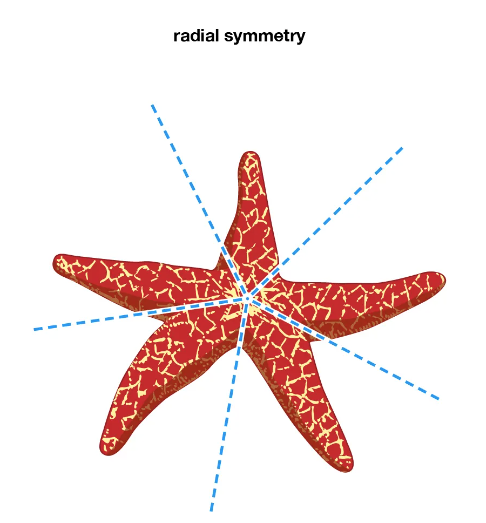
43
New cards
Bilateral symmetry
Right and left sides are symmetrical
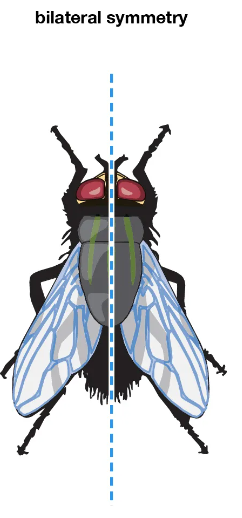
44
New cards
Dichotomous Key
A series of paired opposing statements which guide the user to the identity (or allows the classification) of an item or organism using its visible features.
* Each time you are given a choice of two features, but you should always follow the one that applies: each choice leads to another choice until the organism is narrowed down to its genus and finally to its species
* Each time you are given a choice of two features, but you should always follow the one that applies: each choice leads to another choice until the organism is narrowed down to its genus and finally to its species
45
New cards
Branching keys
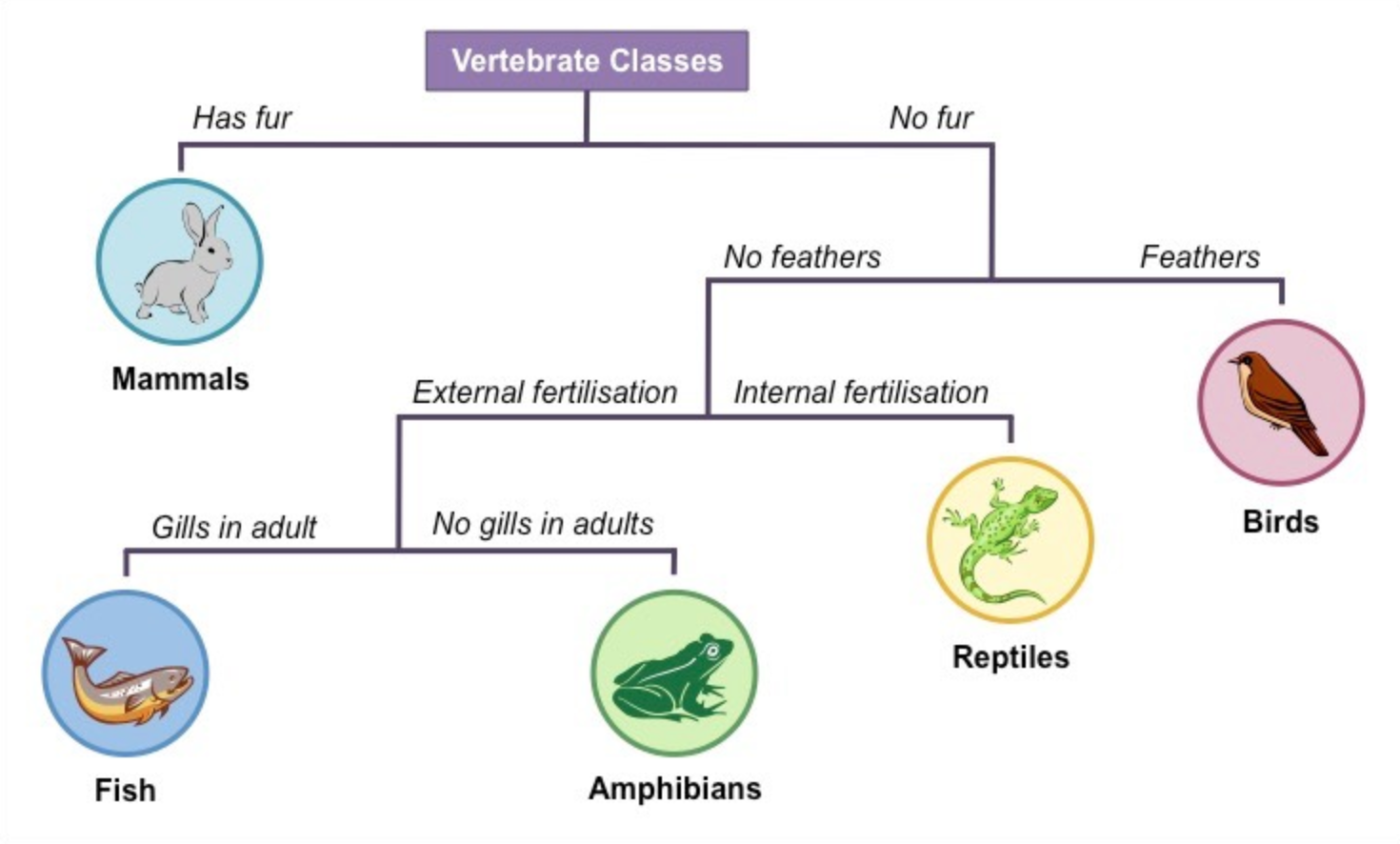
46
New cards
Numbered keys
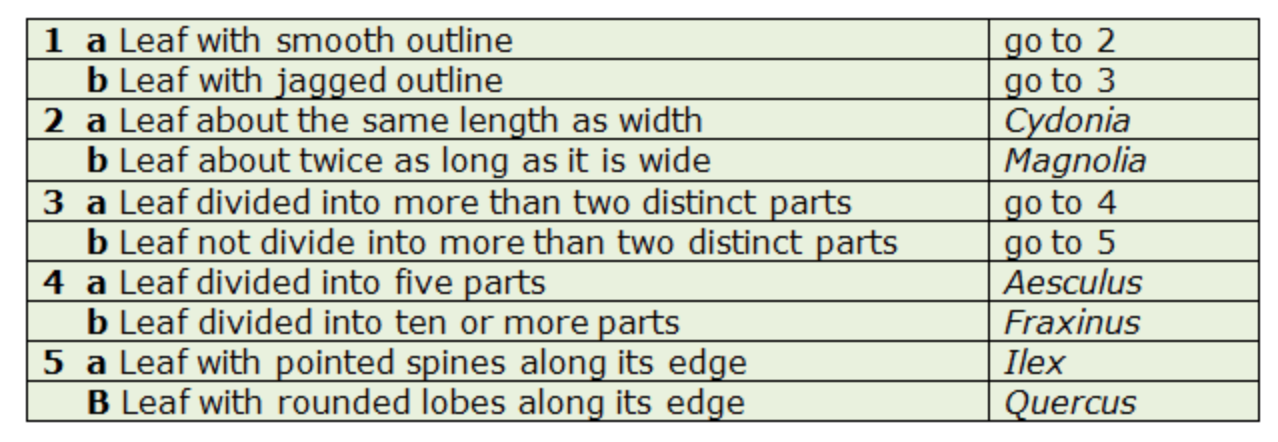
47
New cards
Vascular tissue
Transports water and sugars throughout the plant.
48
New cards
Rhizoids
Small root-like structures that help bryophytes to attach to the soil.
49
New cards
Xylem
A type of vascular tissue composed of non-living cells that transport water.
50
New cards
Phloem
A type of vascular tissue that transports sugars throughout the plant.
51
New cards
Chordata
A large phylum of animals that includes the vertebrates together with tunicates (sea squirts) and lancelets. They are distinguished by the possession of a notochord (a long, rod-like midline structure) at some stage during their development
52
New cards
Vertebrates
Vertebrates are a subphylum of **chordata** and are subdivided into seven classes. Subphylum Vertebrata are characterised by having a vertebral column or backbone which supports the spinal cord.
53
New cards
Mammalia characteristics
* Skin covered in hair follicles
* Skin also has sweat glands
* Habitat on land and in water
* Endothermic (warm-blooded) → they maintain their body at a metabolically favourable temperature
* Have four-chambered hearts + four pentadactyl limbs
* Breathing through lungs
* Give brith to young (except five species of monotremes)
* Rely on internal fertilisation for reproduction
* Examples: *platypus, bears, cats and humans*
* Skin also has sweat glands
* Habitat on land and in water
* Endothermic (warm-blooded) → they maintain their body at a metabolically favourable temperature
* Have four-chambered hearts + four pentadactyl limbs
* Breathing through lungs
* Give brith to young (except five species of monotremes)
* Rely on internal fertilisation for reproduction
* Examples: *platypus, bears, cats and humans*
54
New cards
Aves (Birds)
* Skin covered in feathers made of keratin, which are waterproof and insulate the body
* Habitat on land
* Most species can fly and some can also swim
* Endothermic (helps them live in diverse habitats)
* Four chambered hearts + Four pentadactyl limbs (two wings + two legs)
* Breathing through lungs (well-developed lungs to help with air ventilation) → need a lot of oxygen as it takes a lot of energy to fly
* Internal fertilisation + lay eggs
* Parent their offspring by feeding them and building them nests
* Examples: *hawks, sparrows and flamingos* (10, 000 species)
* Habitat on land
* Most species can fly and some can also swim
* Endothermic (helps them live in diverse habitats)
* Four chambered hearts + Four pentadactyl limbs (two wings + two legs)
* Breathing through lungs (well-developed lungs to help with air ventilation) → need a lot of oxygen as it takes a lot of energy to fly
* Internal fertilisation + lay eggs
* Parent their offspring by feeding them and building them nests
* Examples: *hawks, sparrows and flamingos* (10, 000 species)
55
New cards
Reptilia
* Skin is dry and has scales made up of keratin
* Habitat on land
* Ectothermic (cold-blooded) → they regulate their body temperature using external sources, such as basking in the sun
* Internal fertilisation + most species lay eggs (usually with soft shells
* Three-chambered hearts
* Breathing through lungs → makes them more terrestrial than fish and amphibians
* Homodont are sharp and cone-shaped
* Most do not parent their offspring (exceptions: *crocodiles*)
* Examples: *turtles, crocodiles, snakes and lizards*
* Habitat on land
* Ectothermic (cold-blooded) → they regulate their body temperature using external sources, such as basking in the sun
* Internal fertilisation + most species lay eggs (usually with soft shells
* Three-chambered hearts
* Breathing through lungs → makes them more terrestrial than fish and amphibians
* Homodont are sharp and cone-shaped
* Most do not parent their offspring (exceptions: *crocodiles*)
* Examples: *turtles, crocodiles, snakes and lizards*
56
New cards
Amphibia
* Skin is exposed and moist
* Found in a variety of habitats: terrestrial, arboreal (trees) or freshwater aquatic systems
* Ectothermic and can use their skin as a secondary respiratory surface
* Three chambered hearts + four limbs with digits
* Have rudimentary lung sacs that allow for gas exchanges; however, during their larval stage they use gills as they start off by living in the water
* Lay many eggs that are coated in a jelly like substance for protection
* External fertilisation for reproduction
* Most amphibians leave their offspring once they hatch (exceptions: *some species of poison dart frogs*)
* Examples: *frogs, newts, salamanders*
* Found in a variety of habitats: terrestrial, arboreal (trees) or freshwater aquatic systems
* Ectothermic and can use their skin as a secondary respiratory surface
* Three chambered hearts + four limbs with digits
* Have rudimentary lung sacs that allow for gas exchanges; however, during their larval stage they use gills as they start off by living in the water
* Lay many eggs that are coated in a jelly like substance for protection
* External fertilisation for reproduction
* Most amphibians leave their offspring once they hatch (exceptions: *some species of poison dart frogs*)
* Examples: *frogs, newts, salamanders*
57
New cards
Fish
* Covered in slimy scales that protect the body
* Habitat in fresh or sea water, with fins and tails adapted to swimming and balancing
* Ectothermic
* Two chambered hearts
* Breathing through gills
* Most rely on external fertilisation for reproduction
* __Three main classes:__
* Jawless fish
* Cartilaginous fish: *have gill slits instead of an operculum + have no swim bladder*
* Bony ray-finned fish: *largest of the three + have fins supported by a spine, have gills that are covered by an operculum and show a gill slit, have a swim bladder*
* Habitat in fresh or sea water, with fins and tails adapted to swimming and balancing
* Ectothermic
* Two chambered hearts
* Breathing through gills
* Most rely on external fertilisation for reproduction
* __Three main classes:__
* Jawless fish
* Cartilaginous fish: *have gill slits instead of an operculum + have no swim bladder*
* Bony ray-finned fish: *largest of the three + have fins supported by a spine, have gills that are covered by an operculum and show a gill slit, have a swim bladder*